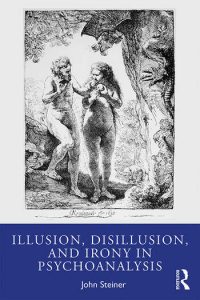Illusion, Disillusion, and Irony in Psychoanalysis, by John Steiner, Routledge, Abingdon and New York, 2020, 167 pp.
Review by Cuneyt Iscan, MD
In lieu of an abstract, here is a brief excerpt of the content:

John Steiner is well-known for the psychoanalytic reader. His first book, Psychic Retreats was published in 1993 followed by Seeing and Being Seen: Emerging from a Psychic Retreat (2011). He is coming from the British Kleinian psychoanalytic tradition and Kleinian ideas permeate every inch of his new book with Steiner’s distinct voice at the same time.
Steiner has established his seminal ideas, his concepts of “pathological organizations” and “psychic retreats” in his earlier work. In Psychic Retreats, he discussed patients who he identified as a subgroup with a certain characteristic clinical presentation. This group of patients presented as stuck in their maladaptive patterns and posed a distinct challenge for the analyst. Steiner, using his clinical work, showed how these patients’ experiences were defensively organized and formed a clinically distinct complex structure that he named “pathological organization.” Steiner postulated “the pathological organization” as an intermediate area between the paranoid-schizoid position and the depressive position. This psychological state served as a defense against unbearable persecutory and depressive anxieties for the patient (Steiner, 1993). The patient, in that sense, chose to inhabit these states as a “retreat” and withdraw to avoid contact both with the analyst and reality. He named these states “psychic retreats.” Steiner’s view offered the theoretical construct to “hold” the patient and the analyst in the Kleinian way. There is compassion in this view for the patient’s need to withdraw and recommendation for the analyst to embrace the patient’s need to be in analysis and yet reject the analytic process in the most fundamental way, hence the impasse.
Steiner extends his idea of “psychic retreats” to “psychopathology of everyday life” in his new book. This book has less clinical focus and more universal themes. He uses literary works extensively, yet the book is not without clinical examples. He skillfully weaves in the “human condition” with the clinical situation. Through the elegant and skillful display of literary works, he reminds us of what we all, as humans, have in common, our need for psychic retreats from the harsh realities of life and how we hold on to illusions to deal with our vulnerabilities. He defines illusions as “a particular form of psychic retreat,” “states of mind to which we can withdraw, mostly to escape from various sources of anxiety and pain, but partly to enjoy the instant gratification they provide” (p. 1). Illusions serve the function of a “retreat” from the unbearable reality<…>
The American Journal of Psychoanalysis, 81, 549–553, November 2021.
Link to Online Publication [fulltext can be requested from the library]. The book is available on loan from the library to members and partners.
About the Author
Cuneyt Iscan, MD, is a Psychoanalyst Member of BPSI and an Assistant Professor at the Department of Psychiatry, University of Massachusetts Medical School in Worcester, MA.
Previous Posts:
Randall H. Paulsen, MD & Don R. Lipsitt, MD (2021). The Balint Group: The Arc of the Enduring Bridge Between Psychoanalysis and Medicine. In Schwartz, H. (Ed.), Applying Psychoanalysis in Medical Care (pp. 161-189). Routledge.
Alexandra M. Harrison, MD. (2021). Culture – Surprise and the Psychoanalyst. Psychodynamic Psychiatry, 49(4), 487-489.
Stephanie Brody, PsyD (2021). Facing the Facts: Self Disclosure and the Analytic Relationship Swimming in Dark Places. American Imago, 78(3), 485-490.
Sarah Ackerman, PhD (2021). Psychoanalysis from the Inside Out: Developing and Sustaining an Analytic Identity and Practice by Lena Ehrlich, London and New York, Routledge, 2020, 169 pp. The International Journal of Psychoanalysis, 102(4): 822-826.
Lewis Kirshner, MD (2020). Trauma by Lucy Bond and Stef Craps. London: New Critical Idiom, Routledge, 2019, 173 pp. American Imago, 77(4), 800-808.
Cuneyt Iscan, MD (2021). Large-Group Psychology: Racism, Societal Divisions, Narcissistic Leaders, and Who We Are Now, by Vamik D. Volkan, Phoenix Publishing House Ltd, Oxfordshire, UK, 2020, 139 pp. American Journal of Psychoanalysis, 81: 244–248.
José Saporta, MD (2021). Psychoanalysis and Our Cultural Crisis. Subject, Action, & Society: Psychoanalytical Studies and Practices, 1(1): 91-109.
Elsa Ronningstam, PhD, Mark Goldblatt, MD, Mark Schechter, MD, Benjamin Herbstman, MD (2021). Facing a patient’s suicide—The impact on therapists’ personal and professional identity. Practice Innovations, 6(2), 89–106.
Anton O. Kris, MD (2021). Love Is the Great Educator: Response to Richard Frank and Mel Bornstein. Psychoanalytic Inquiry, 41(4-5), 289-291.
Alex Hoffer, MD (2020). Psychoanalysis as a Two-Person Meditation: Free Association, Meditation, and Bion. The American Journal of Psychoanalysis, 80(3): 331–341.
Nancy J. Chodorow, PhD. (2021). Women Mothers Daughters: The Reproduction of Mothering After Forty Years. In Bueskens, P., ed. Nancy Chodorow and The Reproduction of Mothering: Forty Years On. Palgrave, pp. 49-80.
Anthony D. Bram, PhD. (2021). Introduction – In-Session Use of Digital Material in Child Psychoanalysis and Psychotherapy. The Psychoanalytic Study of the Child, 74(1): 304-307.
Steven H. Cooper, PhD. (2021). Toward an Ethic of Play in Psychoanalysis. The Psychoanalytic Quarterly, 90:3, 373-397.
Diane O’Donoghue, PhD. (2021). Amnesias of a Freudian Kind. Part One. American Imago 78(1), 55-77.
Click here to see a full archive of featured papers. All articles can be requested from the library.

